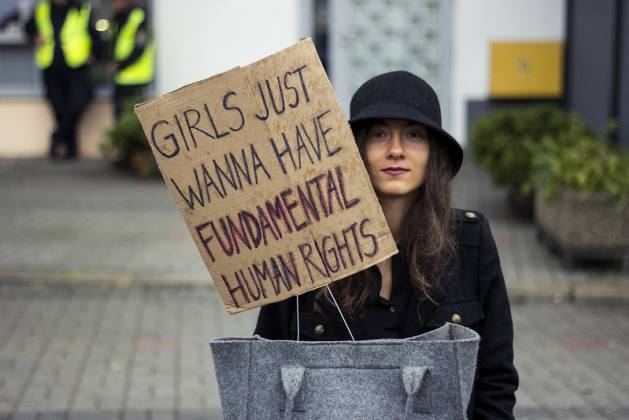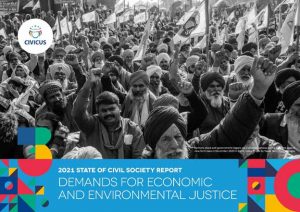By Elma Berisha
‘Global Protest Wave of 2019’, is a term used to describe the unprecedented global phenomenon of prolonged anti-government mass protests occurring throughout 2019. From start to the end of “the year of street protests”, more than 60% of countries across the globe saw millions of people taking to the streets. On the surface, protests were about causes as widely diverse as the vast number of countries involved. Then the Covid-19 outbreak hit, which was first reported in Wuhan, China, in December 2019. As the Covid-19 virus spread across borders in early 2020, for a while, it seemed like the squares and streets had been deserted of anti-government protesters. In response to the coronavirus emergency crisis, most countries forced their populations into major lockdowns. Dramatic measures have ensued, among them closing borders, imposing curfews and travel restrictions, closing down public spaces and banning any social gatherings, including street protests. Hence, the immediate effect of Covid-19 was to quell the 2019 civil mobilization storm across the globe. More than nine months into the crisis, Covid-19 does not seem to have ended the ‘age of the mass protests’, quite the contrary.
Pre Covid-19: The global tide of mass protesting
Social unrest during 2019, from peaceful marches and minor skirmishes to violent clashes with the police, peaked not only in terms of scope and intensity, but also for its crowning achievements. Reminiscent of the Arab spring in the early 2010s, several old-timer heads of states were removed, most notably Abdelaziz Bouteflika in Algeria, Omar al-Bashir in Sudan and Saad Hariri in Lebanon. Driven by decades-old, unbearable socio-economic grievances and rampant corruption among the political leadership, these grassroots movements seemed unstoppable. The rising cost of living and a sense of being shut out of country’s economy have been among key underlying factors. A proposal to tax WhatsApp calls on the part of the Lebanese government sparked mass protests that in many ways have not been subdued. In numerous cases, the rise of prices for basic public services such as utilities, or lack of it due to governments’ state of bankruptcy or negligence, played a role in triggering protests. Popular protests were reignited in Egypt and in October 2019 street protests re-emerged in Syria.
In the age of social media, with increased visibility access and the instantaneous information sharing, the protesters seem to inspire each other from one corner of the world to another. The prodemocracy demonstrations in Hong Kong acted in solidarity and support with the Catalonian protesters, exchanging messages of courage and tactics of resistance. Major protests took place in countries including the UK, Italy, Germany, Austria, New Zealand and more. Nationwide uprisings mark 2019 for France, with the Yellow Vest movement continuing to protest against Macron’s controversial pension scheme. Across the board, an overlap of protest reasons enlisted rallies against austerity programs and the demand for political freedom from direct and indirect political repression. In addition, concerns over eroded democracy via technology interference have played its role. At one point in October 2019, up to one million people took to London’s streets, according to organizers of the “People’s Vote march”, to demand a “final say” on Brexit.
2019 was also the year of the ‘climate strike’. Millions of people took to the streets around the world, demanding that world leaders address the threat of climate change by taking concrete action. Some of the first marches began in Australia, and then spread westward to Asia and across Europe. What was unique about these protests was the youth climate strikers led by the 16-year-old Greta Thunberg who captivated the world’s attention, as well as, the eleventh hour sense of urgency to address the imminent threat of global warming. These September protests were likely the largest climate strikes in world history. Needless to say, these were not merely an impressive series of synchronised marches driven by youthful idealism. The year had already been marked with some of the most extreme climate change related events. July 2019 is reported to have been Earth’s all-time hottest month in recorded history, bringing two extraordinary heat waves to Europe. Australia suffered its hottest year on record in 2019, creating some of the most apocalyptic fires ever seen locally and beyond. Meanwhile, the world stood in shock witnessing the burning of the Amazon rainforest in Brazil and the nearby forests in bordering Bolivia. Similar apocalyptic fire bursts were faced in California. The emergency pollution in Mumbai, the outlandish flooding in Venice and in Jakarta, the deadly landslides, hurricanes, typhoons, cyclones, and the list of extreme climate change related events in 2019 went on, leaving thousands of people stranded. The heavy monsoon rains caused devastating flooding to India, marking it as Earth’s deadliest weather-related disaster of 2019.
Echoing in unison, the message of climate strikers blamed governments as having failed to take timely and weighty measures to tackle the climate change. The political leadership has let the people down. Some have seen this as symptomatic of a broader and deeper crisis of leadership at both global and country level. It reflects an ever intensifying trust deficit on political elites and feeling of resentment on how they are handling vital issues faced by societies today. A sense of detachment between self-absorbed and negligent leadership and the pressing concerns of the masses prevail, be it at climate front, political, socio-economic or cultural. This sceptical attitude of the masses towards political elites has also manifested itself in the widespread discontent of how governments are handling the Covid-19 crisis. In any event, voices have been heard accusing the governments of not giving the true number of cases during the initial weeks of the pandemic. In countries where the reported numbers were relatively high, the people were adamant that the government was exaggerating the statistics, to leverage for whatever imagined political reason. In countries where the reported numbers were relatively low, the people were adamant that the government is covering up the dire situation. In this vein, the Covid-19 crisis has expanded the dropdown list of reasons to street protesting, ranging from deeply serious social grievances to populist, ridiculous ones.
The twists and turns of pandemic protesting
For a significant period of time, the global economic affairs have been operating in bad faith. In this sense, the global economy was already heading to a recession even before the Covid-19 crisis hit. To many, the pandemic crisis has only widened the inequality cracks in the system, putting a magnifying glass on socio-economic inequality and governance failures. And to some, the sentiment is that Covid-19 has validated the case of the 2019 tide of protests. The crisis has highlighted the need for more government investment in vital public services and healthcare systems, to reform them by eliminating corrupt practices and be made more efficient, reinforcing the protesters’ case for the need for reforms. Moreover, the pandemic has incurred significant financial costs and losses to individuals and businesses across the board at a societal and global level. Lockdown orders and widespread business closures have thrown millions of people out of work, swelling the ranks of the unemployed. This has contributed to impoverishing further middle classes and pushing the working poor and borderline poor further to the existential edge. The crisis has brought into the limelight the vulnerability of large swathes of informal workforce without social security of any sort. Lacking savings and health insurance, these workers need to keep their daily jobs to make ends meet month-to-month. Countless people do not have the option of working from home via Zoom. Hence, with Covid-19, there has been new waves of mass protests against top-down imposed restrictions. “We Want to Work” and “End the Lockdown” read signs that some of the recent protesters display.
As the pandemic reality sank in, protesters complied with physical distancing measures and began to make much of their statements through altered face mask looks and messages. The Black Lives Matter protests have been going on for more than 70 days across the cities in US since the May death of George Floyd in police custody in Minneapolis. This tragic event sparked another iconic wave of global protests across the world. It spread with such speed and vengeance, almost rendering the pandemic crisis into oblivion for a while. Early June, as tens of thousands marched to demonstrate against racism, authorities warned of a surge of another wave of COVID-19 infections in the following weeks stirred by protesting crowds. Antiracist protests were held in London and cities across Britain, as well as Paris, Berlin, Tokyo, Sydney, Auckland and elsewhere. The rallying was consciousness-shattering when it comes to revealing the reality of racial discrimination plight, highlighting the deep social divide and the institutionalised racism. The rallying was almost earth-shattering for in the weeks that followed considerable number of statues of slave trader and colonial figures fell to the ground at the feet of protesters. Since then, the demands for racial equality have become louder, amplified by social media and millions of people in lockdown, observing the event.
Given the interim ebbing of pandemic waves, and indeed, despite of it, countries are seeing growing protests against the governments for its handling of the pandemic. Protesters do tend to go on defying the imposed coronavirus related SOPs. In western societies the motivating factors are rebellion against top-down imposed restrictions. Mask-wearing and tightening of other coronavirus prevention measures is seen as infringement on citizens’ individual liberties. As more societies adopt mandatory mask orders, supporters of an ‘anti-mask’ rally find the luxury to question official narratives of pandemic crisis and its realities. Rallies against imposed restrictions in direct breach of rules are held across Europe, the Americas and Australia. Of course, some of these libertarian concerns are amplified by conspiracy theories pointing to ‘mind control’, ‘sanitary dictatorship’, “vaccination fascism” and more, implying that the virus is just another ‘political stunt’ of the global elite and that the virus is in fact harmless. Across the board, while all protests are equally discontent with governments’ handling of the crisis, the discontent is directed towards opposing ends of the spectrum. In the US, the ongoing protests reflect the divided public opinion on school opening as the infection rates are climbing across the country. Parallel rallies, both pro opening of the schools in September, and against opening of the schools are organized. In some countries protesters call for looser measures, in others they call for tighter measures. In Sweden, for instance, people have come out to express dissatisfaction at their government’s failure to impose stricter measures. The level of desperation venting has reached such heights that, in some places, it is unclear what the protesters’ dissatisfaction is about, or what are the protesters demanding of the government to implement: start a complete lockdown or end an ongoing one?
The pandemic has proven to be a fertile ground for populism. In some countries, the coronavirus conspiracy theories may have closed the gap between far-right populists and the left-wingers, as it has fuelled common fears of top-down imposed measures and increased social control. Hate mongering against elites, immigrants, minorities, and against any ‘others’ at all, both vaguely and bluntly-defined, is now being re-cast in terms of all sorts of coronavirus conspiracies. One could say that, populism is some sort of inverse quixotism, in the sense that, the challenges faced in this day and age are objective and real (the pandemic, climate change, rising inequality, ‘secular stagnation’, democratic deficit, rampant corruption, religious extremism, etc.), but populism seeks to fix them through self-aggrandising collective illusions (all sorts of mushrooming supremacist grand narratives and taglines), and discursive constructing of antagonistic ‘others’. The leadership often goes with the populist flow as and when it suits their political expediency. In this scheme of us versus them, the corrupt and lethargic elites and lack of global leadership is both cause and effect of a crisis made worse. It is therefore high time to act for those who reject both the realities of institutionalised discriminations and populisms as a means to solve any of the problems in vogue. Contrary to self-entitled claims, populists are not the people. The people are not the populists, neither are the elites, although they encompass both. The latter are the fringe of reality of the people. Both the elitists and the populists are part of the problem, not part of the solution. The people are the defining reality and they have the power to define the course of events in a more rational, inclusive and progressive way, in order to pragmatically mitigate and resolve the problems we confront. Undoubtedly and fortunately, the majority of the protesters during and before the pandemic fall on this side of the fence.
5 September 2020
Elma Berisha is a member of the Executive Committee of the International Movement for a Just World (JUST).
Source: http://www.just-international.org/mediastatement/social-protesting-pre-and-post-covid-19/




